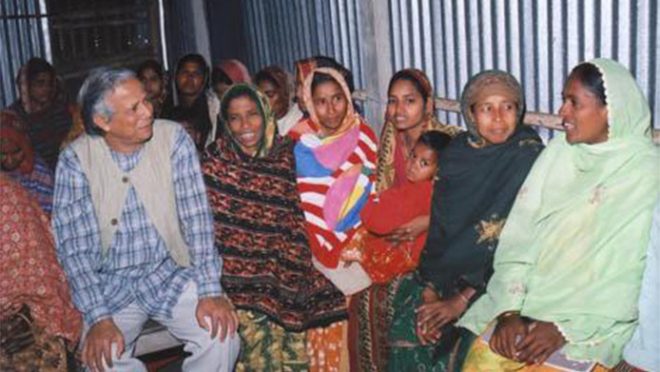Small loans, big dreams: Microfinance, a pathway to financial independence for women entrepreneurs
Small loans, big dreams: Microfinance, a pathway to financial independence for women entrepreneurs

“Loans are better than charity to interrupt poverty?” – is the principle Grameen Bank was founded on.
Nobel peace prize winner Dr Muhammad Yunus aspires for a world with three zeros: Zero poverty, zero unemployment and zero carbon emissions. In this world everyone has access to financial opportunities, entrepreneurs create jobs and people create a healthy planet through sustainability.
Loans play a big role in expediting people’s entrepreneurial endeavours. To begin with, what is microcredit, and how does it work?
Let’s hear the story of Amrapali, a poor farmer who lived in a village where women were entirely dependent on the male members of their households—even for small tasks like mobile recharge—and had no access to loans or financial services. How is she supposed to improve her financial condition and take out loans if she doesn’t even have anything to offer as collateral?
Dr Muhammad Yunus’s microcredit model, a groundbreaking approach to providing financial services to the underprivileged, especially those who don’t have access (mostly women) to conventional banking systems. Microcredit is a type of banking service provided to low-income individuals or groups who otherwise wouldn’t have access to financial services.
It differs from the conventional banking in the sense that microcredit doesn’t require collateral or any mortgages as security for loans. The loan sizes are usually smaller and it’s a trust-based lending rather based on credit history. The loan system is built on step-by-step incremental loans.
So, the borrowers initially receive a small portion of loans and upon successful repayment they can access higher sums in later cycles. This incremental increase in loan size lowers the default risk and promotes discipline. Unlike traditional banks, which prioritise profit, the concept encourages social development in addition to financial services.
These programmes give people the chance to engage in business or agriculture, which generates income and helps them settle debt. Since many borrowers can’t provide collateral, microlenders often group them together. After getting the loan they have to repay them it a group. This way, everyone works together to make sure the loans are repaid, creating a sense of shared responsibility that helps ensure repayment.
Beyond just providing the loans the Grameen model pushes borrowers to follow a set of social values called the “Sixteen Decisions,” which include pledges to social justice, health, and education. The goal of this emphasis on holistic development is to raise the borrowers’ and their communities’ general standard of living.
Grameen Bank’s interest is one of the lowest across the world. Since its inception, Grameen Bank has disbursed $36 billion collateral-free microcredit loans to more than 10 million borrowers, of which 97% are women. The Grameen Foundation oversaw 42 initiatives in 13 countries in 2022, most of which were aimed at assisting women and girls gain access to financial services, developing climate-smart agriculture, and assistance with their general well-being.
One such example is Amrpali tale, she was able to create her own business, obtain loans, and become financially independent thanks to microfinance. As she exemplifies how accessible financial systems can empower women and change communities, Amrapali has emerged as a hero in her village. The idea is that loans, rather than charity, are a better way to break the cycle of poverty because they provide people the chance to start their own businesses or engage in agricultural or business ventures, which generate income and help lower debt.
According to Dr Yunus, “Making money is a happiness. And that’s a great incentive. Making other people happy is a super-happiness”.


